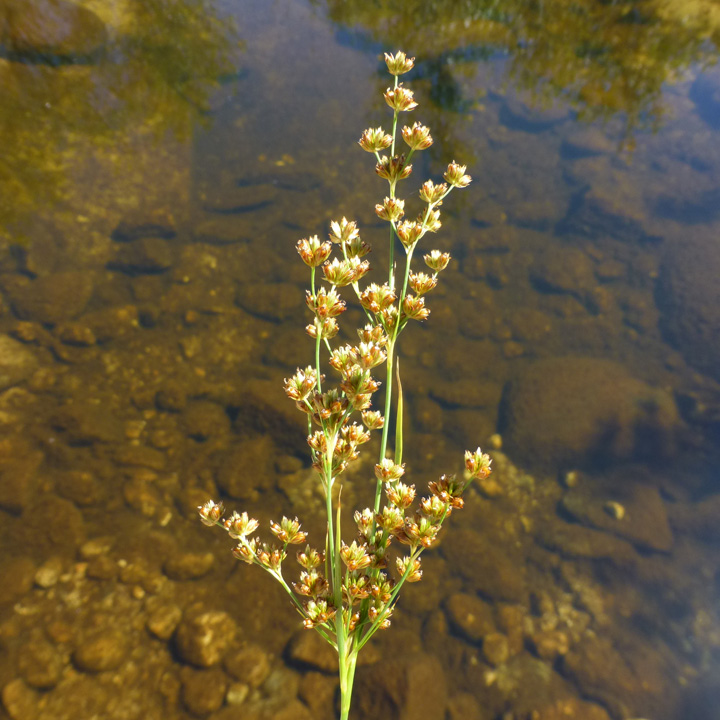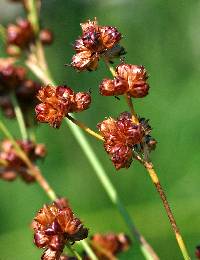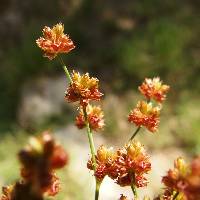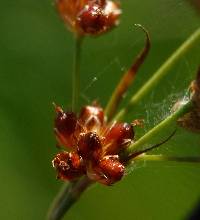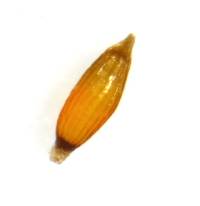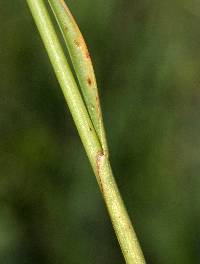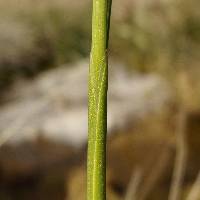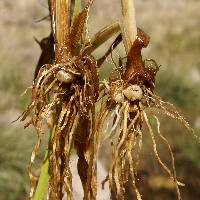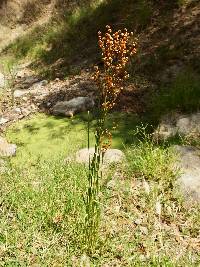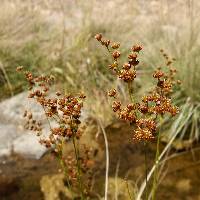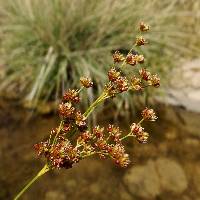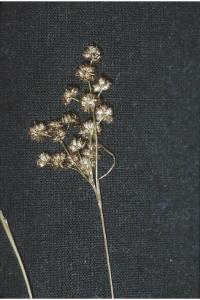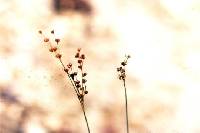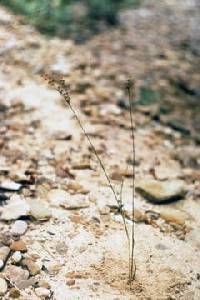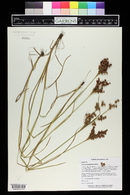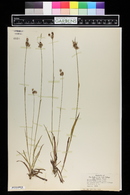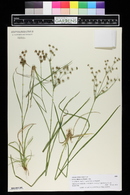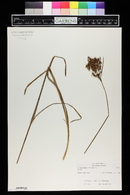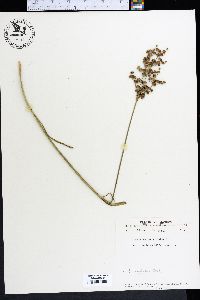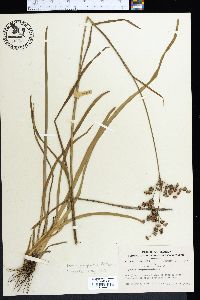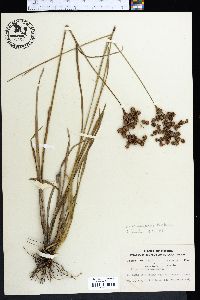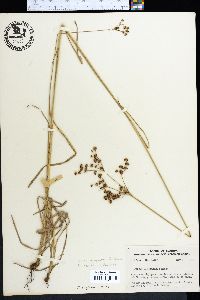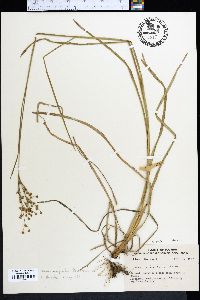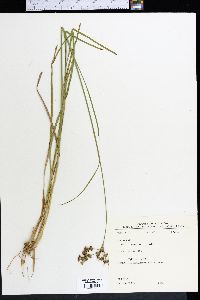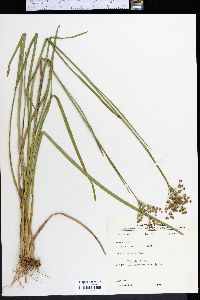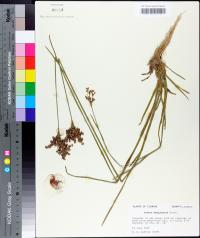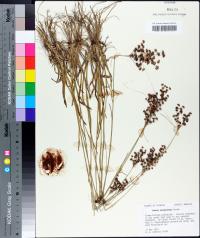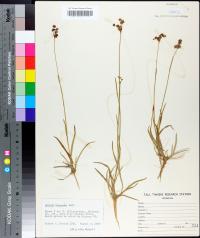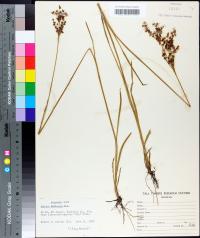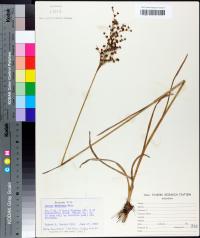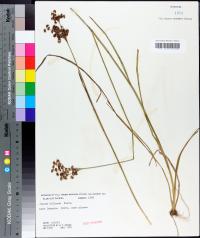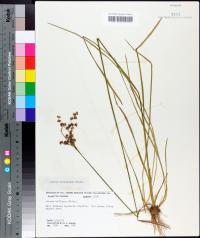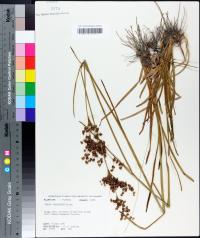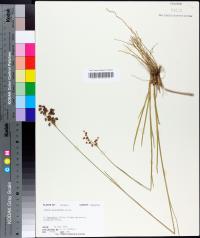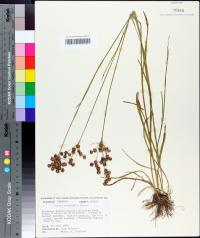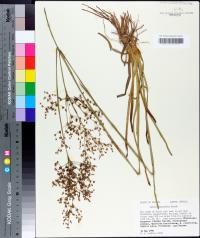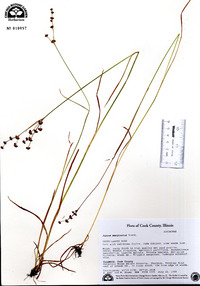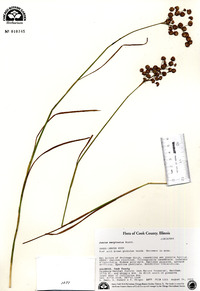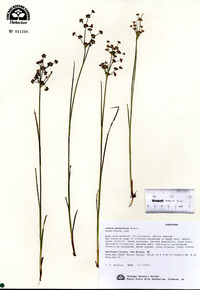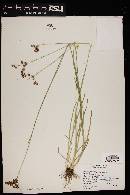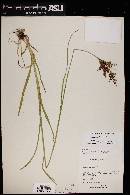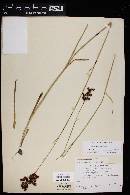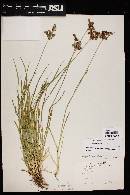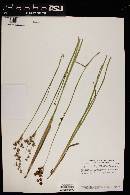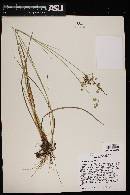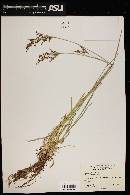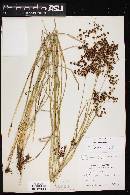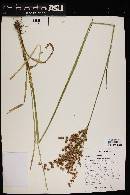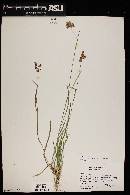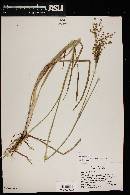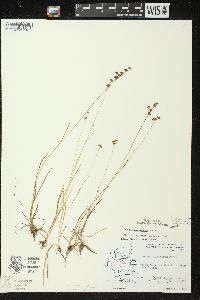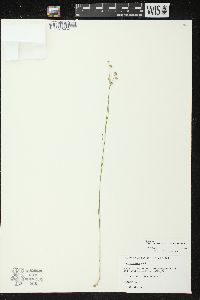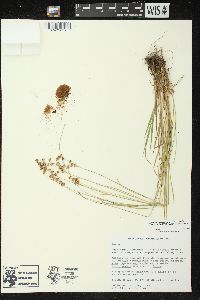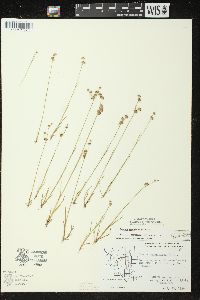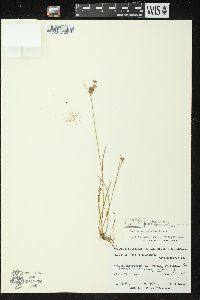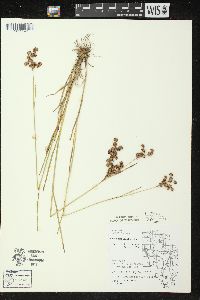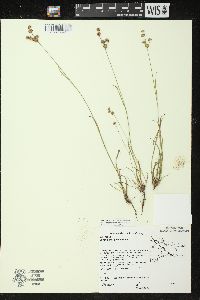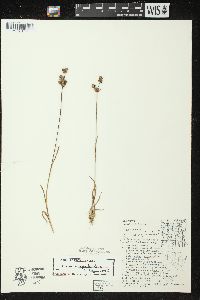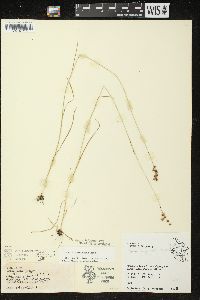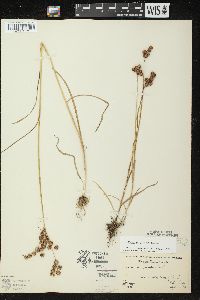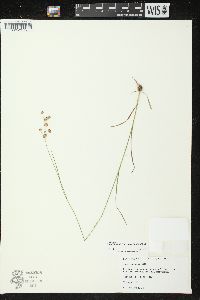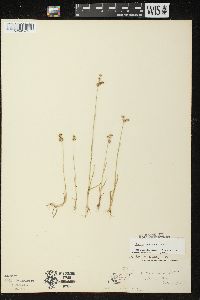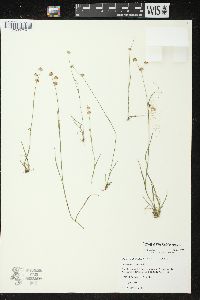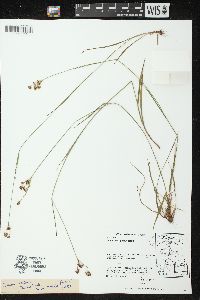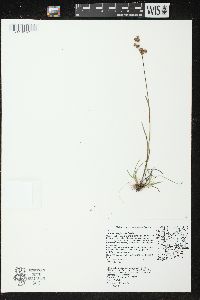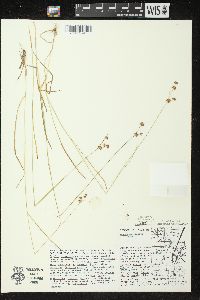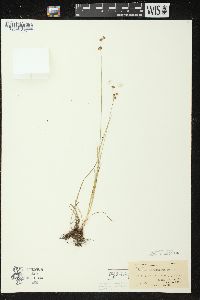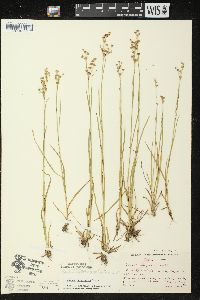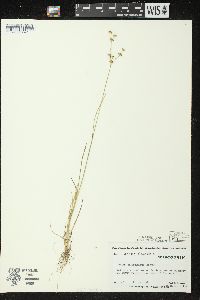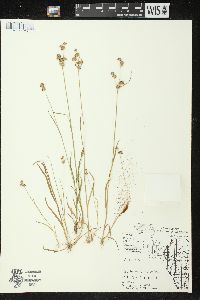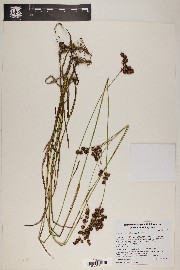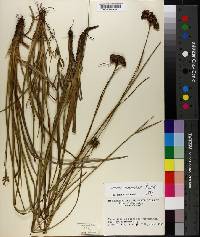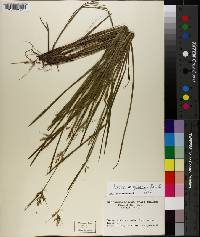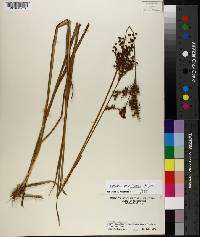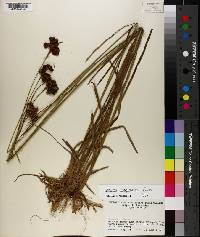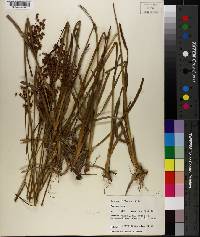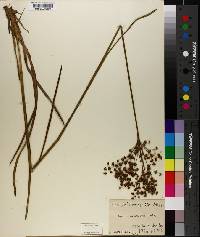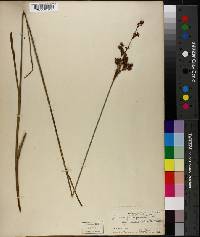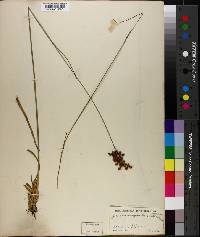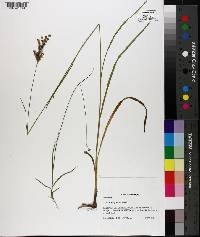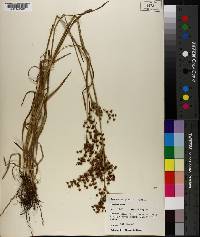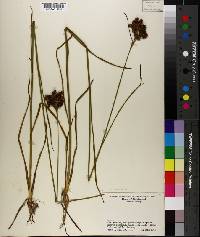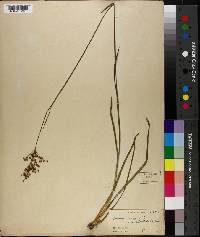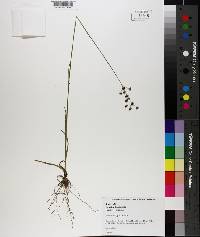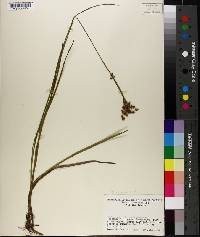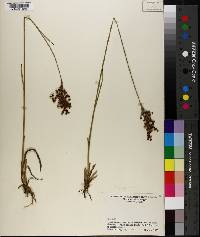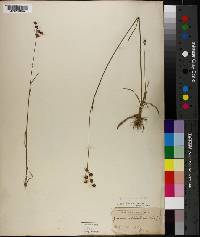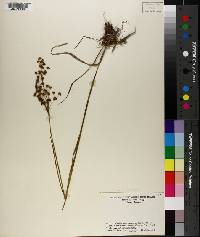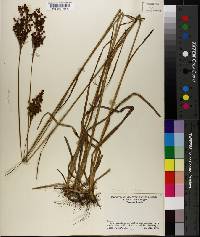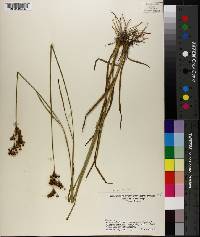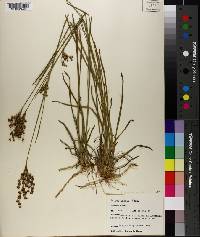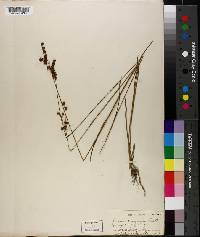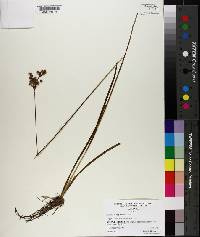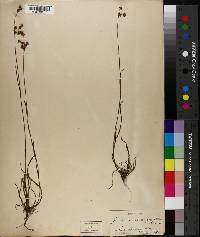Juncus marginatus
|
|
|
|
Family: Juncaceae
Bog Rush, more...grassleaf rush
[Juncus biflorus f. adinus Fernald & Griscom, moreJuncus cylindricus , Juncus marginatus var. aristulatus , Juncus marginatus var. setosus Coville, Juncus marginatus var. vulgaris Engelm., Juncus setosus (Coville) Small] |
Herbs, perennial, occasionally tufted, sometimes rhizomatous, 3--13 dm. Rhizomes short, knotty. Culms compressed. Leaves basal and cauline; auricles 0.5--1.5 mm, apex rounded, membranous; basal blade flat, 20--4.5 dcm x 1.5--5 mm, cauline reduced. Inflorescences glomerules, (2--)5--200, each with (1--)2--10(--20) flowers, mostly open, 3--10(--15) cm; primary bract shorter than inflorescence. Flowers: tepals dark brownish, usually with green midstripe, outer series ovate-lanceolate, 1.8--3.2 mm, margins broad, clear, awned or not, apex acutish; inner series ovate to lanceolate, 2--3.5 mm, slightly longer than outer series, apex obtuse to acute, awned or not; stamens 3, opposite outer tepals, shorter to longer than tepals, filaments 1.1--2.5 mm, anthers 0.3--1.2 mm; style 0.3 mm. Capsules brown and sometimes dark spotted, 3-locular, obovoid to nearly globose, 1.8--2.9 mm, shorter to longer than perianth. Seeds yellow to light brown, fusiform, 0.4--0.7 mm, not tailed. 2n = 38, 40. Flowering and fruiting late spring--fall. Moist to wet sandy, peaty, or clayey soils, usually in open areas including bogs, shores, marshes, and ditches; N.S., Ont.; Ala., Ariz., Ark., Calif., Colo., Conn., Del., D.C., Fla., Ga., Ill., Ind., Iowa, Kans., Ky., La., Maine, Md., Mass., Mich., Minn., Miss., Mo., Nebr., N.H., N.J., N.Mex., N.Y., N.C., Ohio, Okla., Oreg., Pa., R.I., S.C., S.Dak., Tenn., Tex., Vt., Va., W.Va., Wis.; Mexico; West Indies (Cuba); Central America. The number of glomerules per inflorescence, stamen length vs.versus perianth length, and tepal shape have separately and in combination been used to distinguish a number of taxa at various nomenclaturalorial ranks. These characters, however, vary considerably across the distribution of the species (broad sense) and do so independently of one another to the point that if separate taxa are recognized, they pass insensibly among each other.
Perennial grasslike forb 30 cm - 1.3 m tall Leaves: few to several, largest basal (those on stem reduced), quite long (20 - 45 cm), narrow (1.5 - 5 mm), linear, grasslike, flattened in cross section, and lacking crosswise partitions inside (non-septate). The leaves also have a short (0.5 - 1.5 mm), thin and membranous, basal, round-tipped, ear-like appendage (auricle) at the top of the leaf sheath. Inflorescence: a terminal, 3 - 15 cm long, fairly loose, branched structure with the spreading branches ending in two to two hundred, spheric, 0.5 - 1 cm diameter flower clusters. Each flower cluster is a compact head of two to fifteen, tiny, radially symmetric flowers. Inflorescence subtended by a relatively short bract (usually shorter than full inflorescence). Stamens: three, opposite three outer tepals, shorter or longer than tepals, with 1.1 - 2.5 mm long filaments, and shorter anthers (0.3 - 1.2 mm). Pistil: with one superior ovary, a 0.3 mm long style, and three stigmas. Fruit: three-chambered, brown (sometimes dark spotted), 1.8 - 2.9 mm tall (shorter or longer than tepals), inversely egg-shaped to almost globose capsules. Stems: sometimes tufted, erect, flattened or compressed lengthwise, and arising from short, knotted rhizomes. Seeds: many, yellow to light brown, 0.4 - 0.7 mm long, spindle-shaped with wide center and narrowed tips, but without distinct narrowed tails at the ends. Tepals: six in two whorls of three, dark brownish with central green stripe, and broad translucent edges (especially the outer set). The three outer tepals are 1.8 - 3.2 mm long, widely lance-shaped, and pointed or sometimes bristled at the tip. Three inner tepals slightly longer than outer set (2 - 3.5 mm), more egg-shaped, and blunt or short-pointed at tip (sometimes also bristled). Similar species: Juncus marginatus may possibly be confused with the non-native J. compressus, but that species has single flowers on individual stalks rather than compressed heads of flowers, the outer three tepals are usually dark-striped, and all six tepals have rounded or blunt tips. As discussed in the notes below, this species now includes J. biflorus. Species in the subgenus Septati may look superficially similar to J. marginatus, except all those species have leaves that are round in cross section with distinct cross partitions (septa), and the capsules are tapered to narrow, beaked tips. This is the only species in the subgenus Graminifolii that occurs in the Chicago Region or even the Great Lakes. Flowering: June to September Habitat and ecology: Occasional, found in sandy wet ground, marshes, low prairies, sandy clearings, and even often in artificially excavated areas. Occurence in the Chicago region: native Notes: This is quite a variable species, which in the past has been broken up into several varieties and separate species. The characters used to separate these entities from J. marginatus included the number of flower clusters per inflorescence, stamen length in relation to tepal length, and differences in tepal shape, but there is too much variation across the group and there seem to be no identifiable or predictable patterns, thus Brooks and Clemants (2000) use a broad concept for this taxon. For those interested, J. biflorus was supposedly differentiated by having more flower head clusters (20 to 100 vs. 5 to 20 in J. marginatus), leaves over 3 mm wide, and five primary veins per leaf (vs. three in J. marginatus). Etymology: Juncus is the classical name for Rush. Marginatus is Latin for "with borders", presumably in reference to the broad translucent edges on the outer tepals of the flower. Author: The Field Museum FNA 2000, Martin and Hutchins 1980, Kearney and Peebles 1969 Common Name: grassleaf rush Duration: Perennial Nativity: Native Lifeform: Graminoid General: Perennial tufted herb sometimes bulbous at the base, with short knotty rhizomes from 30-130 cm. Vegetative: Compressed stems, transversely flattened, sheaths with rounded auricles; basal blades flat, 20-45 cm by 1.5-5 mm, cauline blades reduced. Inflorescence: Glomerules 5-200, each with 2-10 flowers, mostly in open cyme, 3-10 cm with primary bract shorter than inflorescence; tepals dark brown with green midstripe, outer series ovate-lanceolate, 1.5-3.5 mm, margins broad, clear, apex acute; inner series ovate to lanceolate, 2-3.5 mm, slightly longer than outer series, obtuse to acute apex; 3 stamens, opposite outer tepals, filaments 1-2.5 mm, reddish anthers; capsules brown and sometimes dark spotted, 3-locular, obovoid to nearly globose. Ecology: Found in moist to wet soils, often in sandy or clayey soils from 2,500-4,500 ft (762-1372 m); flowers June-August. Notes: Long compressed stems, along with numerous glomerules are distinctive. The stems thin out near summit, where many glomerules on open cyme are subtended by a long thin bract. Glomerules can be small when plant is immature, but they are dense and numerous at anthesis. Ethnobotany: Unknown Etymology: Juncus comes from the Latin jungere, to join or bind, while marginatus means colored margins. Synonyms: Juncus marginatus var. setosus, J. setosus Editor: SBuckley, 2010 Stems cespitose, bulbous-thickened at base, 2-5 dm, seldom taller; lf- sheaths with rounded scarious auricles; principal blades 1-3 mm wide, with 3 prominent veins; invol lf shorter to somewhat longer than the infl; heads 5-20, 4-6 mm thick, subtended by lance-attenuate bracts; fls eprophyllate; sep lanceolate, 2.1-3.1 mm, acuminate or short-aristate; pet 2.3-3.3 mm, oblong with broadly scarious margins, obtuse or rounded; stamens 3, nearly as long as the tep, the anthers reddish-brown, much shorter than the filaments, usually soon shriveling; fr incompletely 3-locular (the partitions not meeting in the center), somewhat turgid-inflated, broadly obovoid, 1.8-2.9 mm, nearly or quite as thick, broadly rounded or somewhat retuse at the tip; 2n=38, 40. Wet meadows and swales; N.S. to Minn. and S.D., s. to Fla. and Tex. Gleason, Henry A. & Cronquist, Arthur J. 1991. Manual of vascular plants of northeastern United States and adjacent Canada. lxxv + 910 pp. ©The New York Botanical Garden. All rights reserved. Used by permission. From Flora of Indiana (1940) by Charles C. Deam [Deam splits this species into two: J. marginatus and J. biflorus. Juncus marginatus sensu stricto has many (5-10) flowers per head and a bulbous base. This form is] frequent in the western portion of the lake area and also in southern Indiana where it is chiefly in the unglaciated area. It is found in moist sandy clearings, in clay fields or meadows, and rarely in marshes and on low prairies and borders of ponds. [Deam's J. biflorus, which usually has only 2-3 flowers per head and elongate, nodulose rhizomes, is] common in southern Indiana in hard white clay soils of low fallow fields and grassy meadows, in roadside ditches, and rare in open flat woods; infrequent in the lake area in moist open sandy or gravelly habitats, especially on borders of lakes. …… Indiana Coefficient of Conservatism: C = 4 Wetland Indicator Status: FAC |
|
|
|

